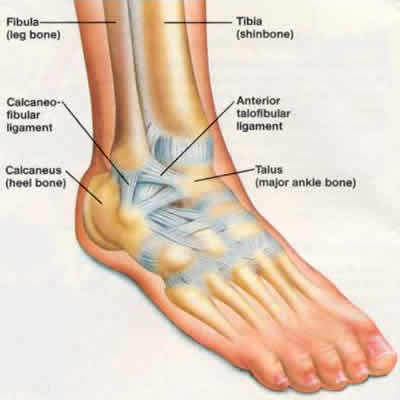Ankle Ligament Injuries
The ankle sprain is the most common ankle ligament injury. Ankle sprains can range from a mild one to a severe one, depending on the damage to the ligaments. The different grades of sprains are:
- Grade 1 Sprain (Mild): will have slight stretching and microscopic tears of the ligament with mild tenderness and swelling of the ankle.
- Grade 2 Sprain (Moderate): the ligament will have partial tearing with mild tenderness and swelling of the ankle. The ankle joint might have abnormal looseness.
- Grade 3 Sprain (Severe): the ligament will be completely torn with critical tenderness and swelling of the ankle and sometimes instability.

Non-Surgical Treatment
Most sprains can be treated without surgery. The doctors usually follow a program of 3 phases for all ankle sprains from mild to severe, which might take 2 weeks to sometimes 6 to 12 weeks depending on the severity of the sprain.
- Phase 1: involves resting, ankle protection and reduction of the swelling.
- Phase 2: involves restoration of range of motion, strength and flexibility of the ankle.
- Phase 3: involves maintenance exercises and the return to activities gradually, followed by the normal activities.
The different non-surgical treatment options are:
Rest: Giving proper rest to the arm is the first step towards recovery. The patient is recommended to stay away from sports or strenuous activity.
Icing: is recommended to be done for 20 to 30 minutes at intervals of 3-4 hours for two to three days. This will help reduce the pain and the swelling.
Compression: the bandages or wraps for the ankle’s immobilization and support.
Elevate: the ankle above the heart level for the first 48 hours.
Non-Steroidal Anti-Inflammatory Drugs (NSAIDs): like Ibuprofen etc., can help reduce the pain and swelling.
Crutches: to help while walking
Physical Therapy: is usually recommended with exercises for muscle strengthening and to reduce stiffness and increase flexibility.
Surgical Treatment
Ankle sprains rarely require surgical intervention, only for ones that are not treated by the non-surgical treatment and ones which cause instability even after rehabilitation. The surgical options recommended by doctors are
- Ankle Arthroscopy makes use of Arthroscope and small surgical instruments to remove any loose bones and cartilage or ligament pieces caught in the joint.
- Reconstruction involves the repair of the torn ligament using stitches and sutures. In some cases, the damaged ligament is replaced with a tissue graft.
Ankle Fractures
Ankle Fractures are classified depending on the area of the bone that is broken. The different types of Ankle fractures are:
- Lateral Malleolus Fracture: is the fracture of the fibula bone.
- Medial Malleolus Fracture: is the fracture of the tibia bone.
- Posterior Malleolus Fracture: is the fracture of the tibia back at the ankle joint level.
- BiMalleolar Fracture: is the fracture of 2 of the 3 parts of the ankle’s malleoli.
- TriMalleolar Fracture: is the fracture of all the 3 parts of the ankle’s malleoli.
Non-Surgical Treatment
The different non-surgical treatment options are:
- Rest and Immobilization: Giving proper rest to the ankle is the first step towards recovery. The patient is recommended to stay away from sports or strenuous activity and keep weight off the ankle.
- Splint: is recommended by doctors to accommodate the swelling and also provide support to the broken ankle.
- Cast: After the improvement of the initial swelling, a cast or a fracture boot has to be applied to the injured ankle for protection and immobilization.
Surgical Treatment
There is a different for each type of fracture as given below:
- Lateral Malleolus Fracture: the broken bones are held together with screws and metal plates, which are attached to the bone’s outer surface. In some cases, a screw or rod is used to hold the broken bones together till they heal.
- Medial Malleolus Fracture: The ankle joint undergoes impaction or indenting, where force is used to push the end of one bone into the other one. An impacted fracture requires bone grafting.
- Posterior Malleolus Fracture: Screws are placed from the front of the ankle to
the back and vice versa. Another option is to place a plate and screws along the back of the shin bone.
- BiMalleolar Fractures: are usually treated with a combination of the treatment of lateral and medial malleolus fractures.
- TriMalleolar Fractures: are treated using all the techniques used for lateral, medial and posterior malleolar fractures.


